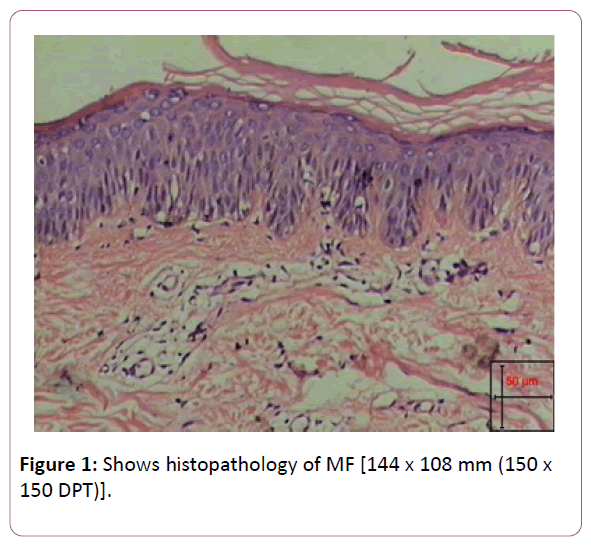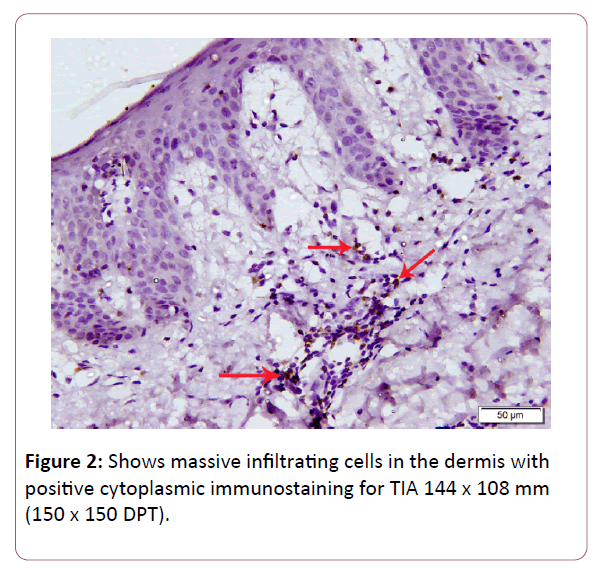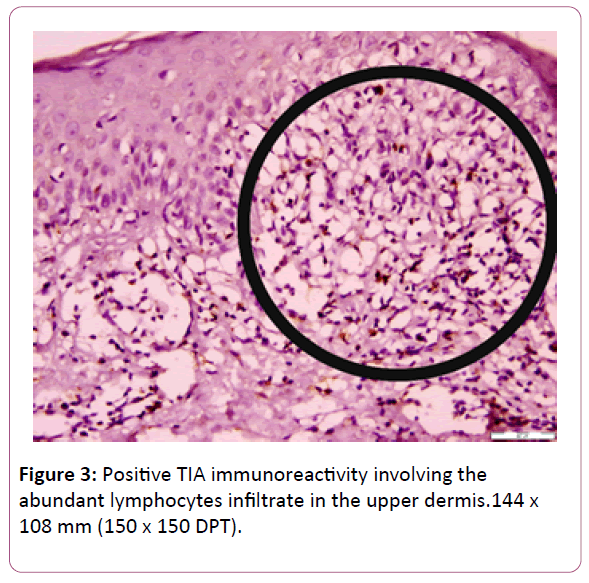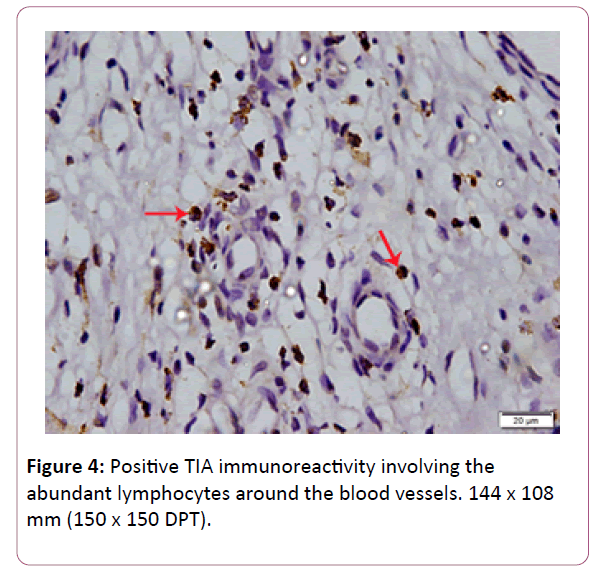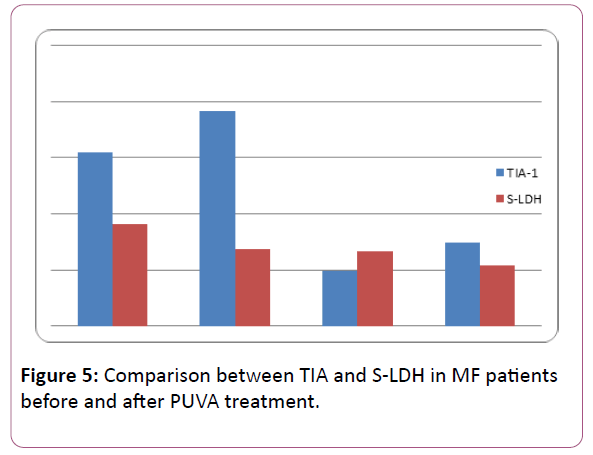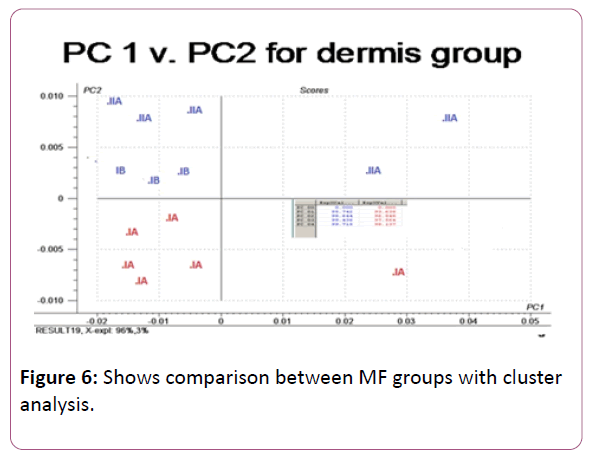AF El Bedewi1,2*, GhK El Khalafawy2 and SS Sayed3
1National Synchrotron Light Source, Brookhaven National Laboratory, Upton, New York, USA
2Health Radiation Research Department, Dermatology Unit, National Center for Radiation Research and Technology, Egyptian Atomic Energy Authority, Cairo, Egypt
3Histology Department, Faculty of Medicine, Cairo University, Egypt
- *Corresponding Author:
- Ahmed El Bedewi
Health Radiation Research Department
Dermatology Unit
National Center for Radiation Research and Technology
Egyptian Atomic Energy Authority
Cairo, Egypt
Tel: 44691743
E-mail: aelbedewi@gmail.com
Received Date: September 13, 2017; Accepted Date: September 18, 2017; Published Date: September 25, 2017
Citation: Bedewi AE, Khalafawy GE, Sayed SS. Prognostic Significance of TIA-1 Cytotoxic T cells versus SIRM in Cutaneous T-Cell Lymphoma. Int J Appl Sci Res Rev. 2017, 4:8. doi: 10.21767/2394-9988.100059
Keywords
Cutaneous T-cell lymphoma; Mycosis fungoides; Prognosis; SIRM; TIA-1
Introduction
Mycosis Fungoides (MF) is one of the most common forms of primary Cutaneous T-Cell Lymphomas (CTCL) [1]. It is very difficult to distinguish between malignant T cells in early-stage MF and benign reactive cells in inflammatory dermatoses [2]. Also, Cytotoxic T-Lymphocytes (CTLs) can recognize and induce target cell cytolysis [3]. Moreover, activated lymphocytes can mediate cell lysis by releasing perforin, granzymes, and TIA-1 (Tcell intracytoplasmic antigen) [4,5]. It should be pointed out that TIA-1 is a cytotoxic protein that is specifically expressed by cytotoxic CD8 positive T cells and natural killer cells. TIA-1 is an intracellular protein of cytotoxic lymphocytes that can induce apoptosis [6]. In 1999, Vermeer and his colleagues revealed that expression of cytotoxic proteins by neoplastic T cells in MF; increases with progression from plaque stage to tumor stage disease [7].
The prognosis of CTCL is usually based on the classification of the International Society for Cutaneous Lymphomas/European Organization for Research and Treatment of Cancer (ISCL/ EORTC), which developed the following markers: stage, age, sex, cutaneous histologic features of folliculotropism, CD30 positivity, proliferation index, large-cell transformation, WBC/ lymphocyte count, serum lactate dehydrogenase, and identical T-cell clone in blood and skin [8]. However, efficient non-invasive tools for the early diagnosis of lymphoma remain a necessity to be applied clinically. Several studies have reported vibrational spectroscopies and infrared absorption to characterize biological tissues. Infrared spectroscopy can provide insight into protein structure. This technique is sensitive to the backbone amide arrangement of peptide and protein molecules. Synchrotron Infrared Microspectroscopy (SIRM) is a favorable method for a number of reasons: it is adequately sensitive to minimal sample amounts and is not limited by the molecular weight of the sample; yields spectra that are simple to evaluate; does not require protein modifications and is applicable to soluble and membrane proteins [9]. Psoralen Plus UVA (PUVA) is an established first line of treatment of early MF [10].
Aim of Work
The aim of the current study is to evaluate MF progression using TIA-1 and SIRM as prognostic markers. Also, appraise the efficacies of PUVA therapy in MF patients through studying lymphocytic changes before and after treatment.
Patients and Methods
This study is a prospective comparative study that was approved by the Research Ethical Committee (REC) of Cairo University. Patient-informed detailed consent forms were completed by all patients before starting this work. It included twenty patients of early stage mycosis fungoides (IA-IB-IIA) who were recruited from the outpatient dermatology clinic, Cairo University. Diagnosis was based on clinical examination and confirmed by histopathological evaluation. Full detailed history and complete clinical examination were done for all patients by two fixed observers. Routine investigations in the form of CBC, ESR, liver and kidney function tests, fasting blood sugar, urine analysis, Serum Lactic Dehydrogenase (LDH), chest x-ray, abdominal ultrasound, lymph node examination, biopsy, and funds examination were done for all patients.
Early stage MF patients with normal liver and kidney functions were included in the study whereas children less than 12 years, pregnant and lactating females, or any patient with any contraindication to phototherapy were excluded from this study. Patients included in this study, their age ranged from 16-61 years were divided into two groups. Group 1 included 10 patients, 5 males (50%) and 5 females (50%). Three patients were skin type III and seven patients were skin type IV. All patients were stage 1A. The duration of disease ranged from 4 month to 15 years. The duration of treatment ranged from 5 month to 12 month. The total number of sessions ranged from 67-144 sessions, and the total number of joules ranged from 230-1114 J/cm2. Group II included 10 patients, 5 males (50%) and 5 females (50%). Two patients were skin type III and eight patients were skin type IV. The stages were 1B and IIA. The duration of disease ranged from 6 month to 13 years. The duration of treatment ranged from 5 months to 14 months. The total number of sessions ranged from 60-170 sessions, and the total number of joules ranged from 216-912 J/cm2. All patients in the current study received PUVA in the form of oral administration of 8-methoxypsoralen at a dose of 0.7 mg/kg and after 2 h UVA sessions were received 3 times/week.
Immunohistochemical Study
A 6 mm punch biopsies were retrieved from the lesional areas in MF patients. Skin biopsies were prepared and fixed in paraffin blocks. These were cut to obtain 5-6 μ thick sections placed on infrared-reflective MirrIR glass low e-slides (Kevley Technologies, Chesterland, OH) for SIRM studies and then stained by HandE. Immunohistochemical staining for CD3, CD4, CD8, CD20, CD30 and TIA-1. Staining of formalin fixed tissues required pretreatment for retrieving the masked epitopes of the antigens. Immunostaining for TIA-1 required pretreatment by boiling tissue in 10 mM citrate buffer cat number AP-9003 pH 6 for antigen retrieval, while this was done for 10 min and left to cool in room temperature for 20 min. The primary mouse monoclonal antibody (Biocare Medical LLC, USA) for TIA-1 was applied for 60 min. Immunohistochemical staining was completed by the use of ultravision detection system ABC kit (TP-015-HD) (Labvision Vermont, USA), DAB (3,3 di-aminobezidine tetrahydrochloride) as chromogen was applied for each slide and the slides were incubated for 5 min at room temperature. Counterstaining was done using Mayer's hematoxylin (TA-060-MH) (Labvision Vermont, USA). Positive immunoreactivity appeared as brown cytoplasmic granular deposits.
Morphometric Study
The area of positive immune staining was measured in TIA-1 immunohistochemically stained sections from all subjects involved in the study. Measurements were done in 5 nonoverlapping fields at 400x magnification in a field area of 7286.783 μm2 for every subject using Leica Qwin 500C image analyzer computer system (England). Images were captured live on the screen from sections under a light microscope (Olympus BX-40, Olympus Optical Co. Ltd., Japan) with affixed video camera (Panasonic Color CCTV camera, Matsushita Communication Industrial Co. Ltd., Japan). The video images were digitized using Lecia Qwin which is a Lecia's windows based image analysis tool kit fitted to an IBM compatible personal computer with a color monitor. Brown deposits demonstrate positive immune-reactivity. Binary images were generated by color thresholding for the brown color then the area of these binaries is measured by the Lecia Qwin 500 software. This is done for every field of the five fields for each subject to obtain a mean area for each. Mean area percent is the relation between the areas of positivity marked by the binary images to the field area which is 7286.783 μm2.
Synchrotron Infrared Microspectroscopy (SIRM) Study
Synchrotron Infrared (IR) microspectroscopy was performed at Beamline U2B at the National Synchrotron Light Source, Brookhaven National Laboratory, NY, USA. The synchrotron IR source was used to improve the spatial resolution to 10 μm such that only the lymphocyte nuclei were probed. Fourier Transform Infrared Microspectroscopy (FTIRM) spectra were collected in reflection mode with a 10 μm beam. For each spectrum, 128 scans were accumulated with 8 cm-1 resolution. For each biopsy, spectra from 50-60 nuclei were collected from epidermal and dermal cells, all spectra were averaged, the first derivative was generated, and a 9-point Savitsky-Golay smoothing was applied. Principal Components Analysis (PCA) was performed on the average first derivative spectra using the spectral region from 1900-900 cm-1 (Unscrambler 9.8). In addition, the absorbance intensity of the nucleic acids (1210-1265 cm-1, baseline: 1185-1285 cm-1), RNA (1119-1123 cm-1, baseline: 995-1140 cm-1), DNA (1018-1022 cm-1, baseline: 995-1140 cm-1), Amide I (1600-1700 cm-1, baseline: 1480-1715 cm-1) and Amide II (1544 cm-1). Specifically, were calculated for each spectrum using Omnic software v7.2 (Thermo Scientific, MA-USA).
All SIRM was analyzed by Principal Components Analysis (PCA) is a nonparametric procedure that reduces the number of variables into principle components, or the variables that most describe the variability within a set of data. With spectroscopy data, each wavenumber can be seen as a single variable, and therefore there are many variables that must be considered when comparing multiple spectra.
Statistics
All data were subjected to statistical analysis. Cluster analysis and statistical significance between groups for each parameter was determined using a Student t-test and ANOVA (SPSS).
Results
In the current study, 20 MF patients were included 50% male and 50% females with mean of male age was 52.2 ± 7.254, while in case of females was 47.2 ± 11.212.
Histopathological examination of MF biopsies revealed tropism of lymphocytes to the epidermis manifesting psoriasiform hyperplasia, hyperkeratosis, and intraepithelial lymphocytes surrounded with clear halos together with lymphocytic infiltrate in the papillary dermis (Figure 1). All cases had a T cell-dominant infiltrate, with CD3+, CD4+ and CD8+, while both CD20 and CD30 were negative. Immunohistochemical results showed massive infiltrating cells in the papillary dermis with positive cytoplasmic immunostaining for TIA. Positive TIA immunoreactivity can be also seen involving the abundant lymphocytes around the blood vessels as well as the band like infiltrate in the upper dermis (Figures 2-4).
Figure 1: Shows histopathology of MF [144 x 108 mm (150 x 150 DPT)].
Figure 2: Shows massive infiltrating cells in the dermis with positive cytoplasmic immunostaining for TIA 144 x 108 mm (150 x 150 DPT).
Figure 3: Positive TIA immunoreactivity involving the abundant lymphocytes infiltrate in the upper dermis.144 x 108 mm (150 x 150 DPT).
Figure 4: Positive TIA immunoreactivity involving the abundant lymphocytes around the blood vessels. 144 x 108 mm (150 x 150 DPT).
Evaluation of TIA-1 level revealed a significant difference between group I and group II (P<0.05). Also, TIA-1 level showed a highly significant difference before and after PUVA treatment (P<0.001). TIA-1 level after PUVA treatment showed a highly significant difference between group I and group II (P<0.05). Furthermore, Serum LDH showed a highly significant correlation with MF progression (P<0.001). Also, LDH revealed a direct proportional correlation with TIA-1 before and after PUVA treatment as shown in Figure 5 and Table 1.
Figure 5: Comparison between TIA and S-LDH in MF patients before and after PUVA treatment.
| |
Before treatment |
After treatment |
| Group |
TIA level |
S-LDH |
TIA level |
S-LDH |
| I ( IA) |
155.245 ± 59.33 |
90.98 |
192.053 ± 83.168** |
68** |
| II (IB and IIA) |
44.815 ± 12.608 |
66.15 |
74.4159 ± 12.852** |
54** |
| Student t-test: ** <0.001=highly significant,*<0.05=significant |
Table 1: Shows comparison between different MF stages before and after treatment using TIA and S-LDH.
SIRM spectra collected from the nuclei of lymphocytes from each sample revealed that the differences between Amide I/RNA and Amide II/RNA between group I and II were highly significant (P=0.00 and 0.01) respectively as shown in Table 2.
| |
MF (IA) |
MF (IB and IIA) |
| Before PUVA |
After PUVA |
Before PUVA |
After PUVA |
| Amide I/RNA |
4.427 ± 2.2607 |
4.269 ± 1.83* |
5.816 ± 9.756** |
5.2839 ± 0.61* |
| Amide II/RNA |
3.479 ± 1.8967 |
3.257 ± 0.95* |
4.211 ± 7.179** |
4.106 ± 0.41* |
| Student t-test: ** <0.001=highly significant,* <0.05=significant) |
Table 2: Shows comparison between different MF stages before and after treatment using SIRM.
Moreover, both groups before and after PUVA treatment showed significant correlation (P=0.02). When PCA was performed on the dermal SIRM spectra of both groups of MF patients, the scores plot of (PC1) vs. (PC2) revealed that all group I spectra clustered together, while group II clustered separately, these findings are consistent with the usual progression of MF. The PC loadings plot shows that the protein region variability indicates a structural difference with a unique biochemical signature which is important in differentiating MF spectra as shown in Figure 6.
Figure 6: Shows comparison between MF groups with cluster analysis.
Discussion
The affinity of T lymphocytes on early stages of MF for the epidermis and papillary dermis; is apparent as there is rarely significant involvement in the underlying reticular dermis. In 1999, Vermeer and his Colleagues showed that Granzyme B (Gr B) and TIA-1 are cytotoxic proteins that are specifically expressed by cytotoxic CD4 or CD8 positive T cells and natural killer cells. They noticed that the expression of cytotoxic proteins by neoplastic T cells in 54 MF patients increases with progression from plaque stage to tumor stage disease. Moreover, the expression of TIA-1 and GrB was found in 35% and 10% patches or plaques, 55% and 20% tumors without blastic transformation, and 75% tumors with blastic transformation (defined as >50% blast cells). So, they concluded that TIA-1 defines a subpopulation of CD8+ T-cells and NK cells that have cytotoxic activity [7]. Furthermore, tumor-stage MF, showed a significant relation between CD8+ CTLs and survival rate; the high proportions of these cells correlated with a better prognosis [11].
The risk of disease progression from early to advanced disease was anticipated by the Cutaneous Lymphoma International Prognostic Index (CLIPi) developed by Benton and his colleagues in 2013; significant adverse prognostic factors at early diagnosis consisted of five factors were associated with a worse Overall Survival (OS) consisting of age >60 years, male gender, presence of plaques (T1b/T2b), folliculotropic disease and lymph node stage N1/Nx. Moreover, other prognostic variables such as Lactatic Dehydrogenase (LDH), B0a/b, and CD30 status and Total Body-Surface Area Affected (TBSA) and the type of skin lesions were suggested by several authors [12,13].
In the current study, the prognostic value of TIA-1 was evaluated; it was found the expression of TIA-1 was significantly higher in early MF, which was declined significantly by about 71% with progression of the disease. Moreover, PUVA therapy increased the level of TIA-1 in group I and II by 24.1% and 66% respectively. According to ISCL/EORTC classification, serum LDH could be used as a prognostic marker in CTCL. In this study, serum LDH was directly correlated with TIA-1 in both group I and II as shown in (Figure 5 and Table 1), these results confirms that TIA-1 could be used as a prognostic marker for MF.
On the other hand, the current study revealed that lymphocytes in MF lesions were clustered in two clusters, one for group I and the other for group II. Furthermore, there was a significant difference within Amide/RNA ratio within the lymphocytes in both groups of patients according to the disease progression. Both Amide I/RNA and Amide II/RNA in group II were higher than group I significantly. These findings are consistent with the results of Andrus, who found that lymphoma cells in vitro have higher RNA and protein/RNA ratio than normal lymphocytes based on IR spectral differences between proliferating and non-proliferating lymphocytes. In summary, TIA-1 together with SIRM seems to be promising methods for prognosis of MF patients [14-16].
References
- El Bedewi A, El Anany G, El Mofty M, Kretlow A, Park S, et al. (2010) The use of synchrotron infrared microspectroscopy in the assessment of cutaneous T-cell lymphoma vs. pityriasis lichenoides chronica. Photodermatol Photoimmunol Photomed 26: 93-97.
- Clark RA, Shackelton JB, Watanabe R, Calarese A, Yamanaka K, et al. (2011) High-scatter T cells: a reliable biomarker for malignant T cells in cutaneous T-cell lymphoma. Blood 117: 1966-1976.
- El Bedewi A, El Anany G, El Mofty M (2010) Role of Synchrotron infra-red microspectroscopy in studying epidermotropism of Cutaneous T-Cell Lymphoma. J Eur Acad Dermatol Venereol 24: 1047-1050.
- Tian Q, Streuli M, Saito H, Schlossman SF, Anderson P (1991) A polyadenylate binding protein localized to the granules of cytolytic lymphocytes induces DNA fragmentation in target cells. Cell 67: 629-639.
- Szymik B, Woosley JT (1993) Further validation of the prognostic model for stage I malignant melanoma based on tumor progression. J Cutan Pathol 20: 50-53.
- Elder DE, Van Belle P, Elenitsas R, Halpern Q, Gerry D (1996) Neoplastic progression and prognosis in melanoma. Sem Cut Med Surg 4: 336-348.
- Vermeer MH, Geelen FA, Kummer JA, Meijer CJ, Willemze R (1999) Expression of cytotoxic proteins by neoplastic T cells in mycosis fungoides increases with progression from plaque stage to tumor stage disease. Am J Pathol 154: 1203-1210.
- Scarisbrick JJ, Prince HM, Vermeer MH, Quaglino P, Horwitz S, et al. (2015) Cutaneous Lymphoma International Consortium Study of Outcome in Advanced Stages of Mycosis Fungoides and Sézary Syndrome: Effect of Specific Prognostic Markers on Survival and Development of a Prognostic Model. J Clin Oncol 33: 3766-3773.
- Andrus PG (2006) Cancer monitoring by FTIR spectroscopy. Technol Cancer Res Treat 5: 157-167.
- EL Bedewi A, Youssef R, Abdel Halim D, Hegazy R, Willis W, et al. (2013) Biochemical Changes Observed after PUVA versus PUVA plus Methotrexate Therapy in Mycosis Fungoides Using Synchrotron Infrared Microspectroscopy. Int J Pept Res Ther 19: 209-215.
- Vermeer MH, van Doorn R, Dukers D, Bekkenk M, JLM Meijer C, et al. (2001) CD8+ T cells in cutaneous T-cell lymphoma: expression of cytotoxic proteins, Fas Ligand, and killing inhibitory receptors and their relationship with clinical behavior. J Clin Oncol 19: 4322-4329.
- Benton EC, Crichton S, Talpur R, Agar NS, Fields PA, et al. (2013) A cutaneous lymphoma international prognostic index (CLIPi) for mycosis fungoides and Sezary syndrome. Eur J Cancer 49: 2859-2868.
- Danish HH, Liu S, Jhaveri J, Flowers CR, Lechowicz MJ (2016) Validation of cutaneous lymphoma international prognostic index (CLIPI) for mycosis fungoides and Sézary syndrome. Leuk Lymphoma 57: 2813-2819.
- Novelli S, García-Muret P, Mozos A, Sierra J, Briones J (2016) Total body-surface area as a new prognostic variable in mycosis fungoides and Sézary syndrome. Leuk Lymphoma 57: 1060-1066.
- Andrus PG, Strickland RD (1998) Cancer grading by Fourier transform infrared spectroscopy. Biospectroscopy 4: 37-46.
- Elder DE, Van Belle P, Elenitsas R, Halpern Q, Gerry D (1996) Neoplastic progression and prognosis in melanoma. Sem Cut Med Surg 4: 336-348.

